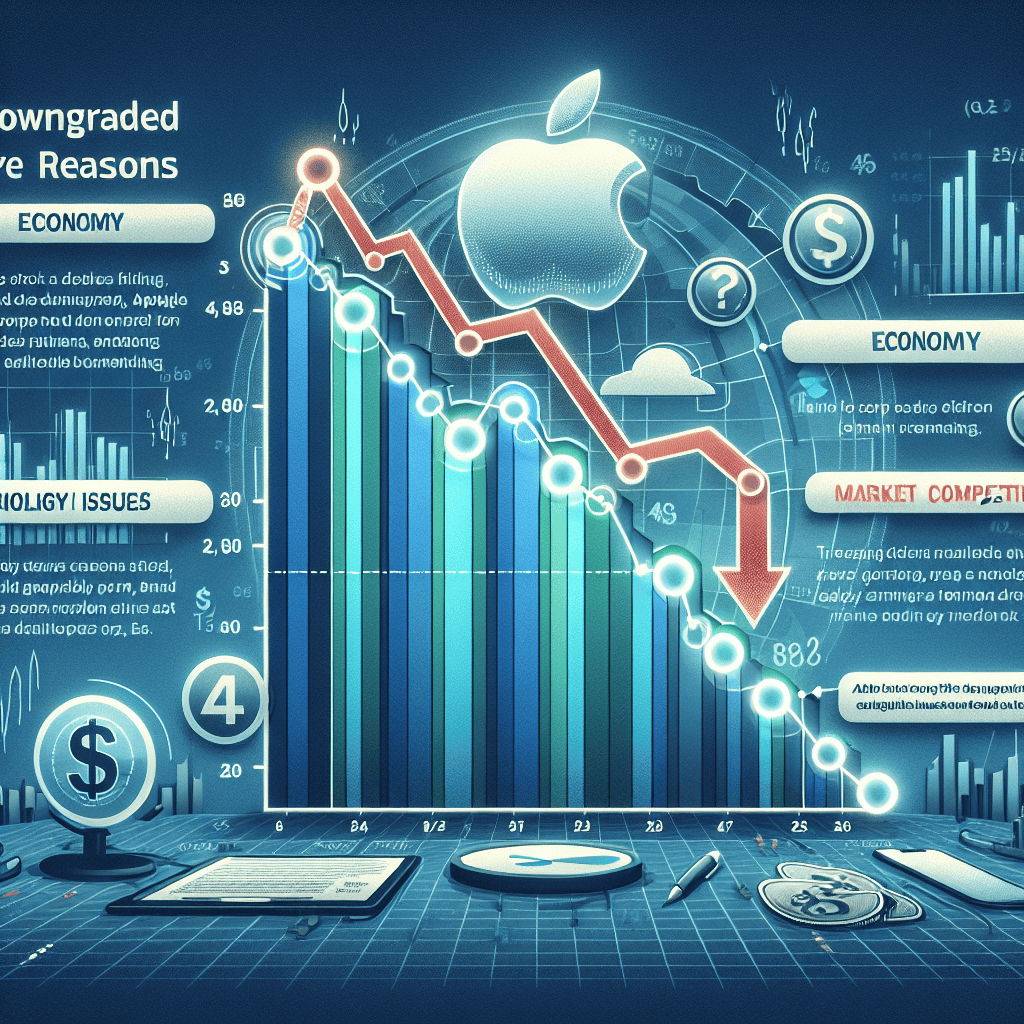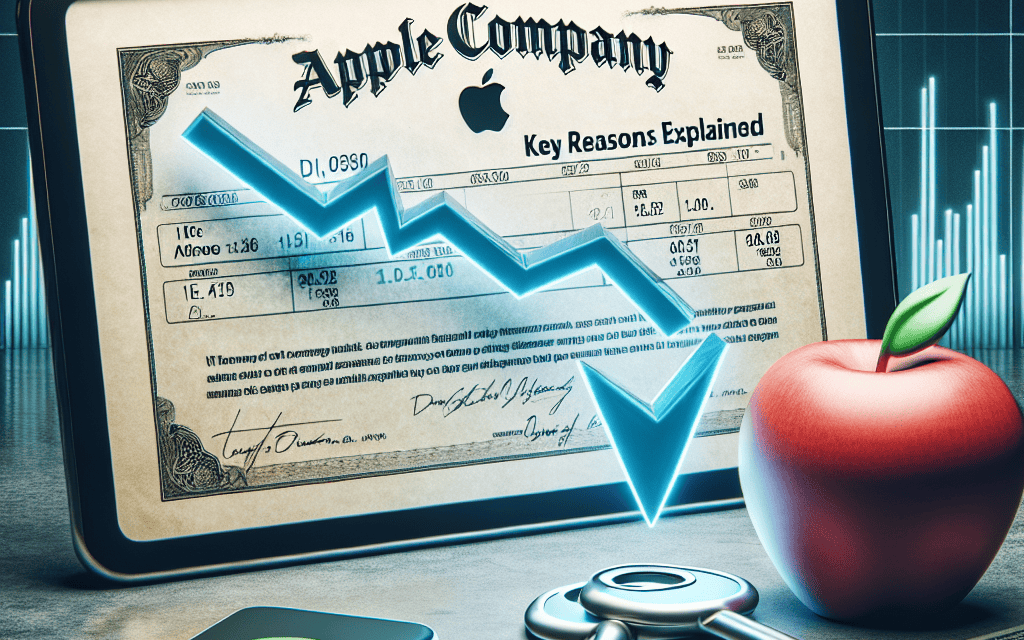“Apple Stock Downgraded: Unveiling the Key Reasons Behind the Pre-Earnings Sell Signal”
Introduction
Apple Stock Downgraded to Sell Before Earnings: Key Reasons Explained
In a surprising move that has caught the attention of investors and market analysts alike, Apple Inc.’s stock has been downgraded to a “sell” rating just ahead of its upcoming earnings report. This downgrade, issued by a prominent financial institution, has raised questions and concerns about the tech giant’s near-term performance and strategic direction. Several key factors have contributed to this decision, including potential challenges in Apple’s product lineup, competitive pressures, and macroeconomic headwinds that could impact its financial results. As the company prepares to release its earnings, stakeholders are keenly observing how these elements might influence Apple’s market position and future growth prospects.
Impact Of Recent Market Trends On Apple Stock
In recent weeks, the financial markets have been abuzz with discussions surrounding the unexpected downgrade of Apple Inc.’s stock to a “sell” rating by a prominent investment firm. This decision, which comes just before the company’s earnings report, has raised eyebrows among investors and analysts alike. To understand the implications of this downgrade, it is essential to examine the recent market trends that have influenced this decision and assess their potential impact on Apple’s stock performance.
Firstly, the global economic landscape has been marked by heightened volatility and uncertainty, driven by factors such as inflationary pressures, geopolitical tensions, and fluctuating consumer demand. These macroeconomic conditions have created a challenging environment for technology companies, including Apple, which relies heavily on consumer spending and global supply chains. As inflation continues to erode purchasing power, consumers may become more cautious with their discretionary spending, potentially affecting sales of Apple’s premium products.
Moreover, the technology sector has been experiencing a broader market correction, with many tech stocks witnessing significant declines in their valuations. This trend has been exacerbated by rising interest rates, which tend to negatively impact high-growth companies by increasing the cost of capital and reducing future cash flow valuations. As a result, investors have become more risk-averse, leading to a shift away from tech stocks and towards more stable, value-oriented investments. Apple’s stock, despite its strong brand and loyal customer base, has not been immune to these market dynamics.
In addition to these external factors, Apple faces internal challenges that have contributed to the downgrade. The company has been grappling with supply chain disruptions, particularly in its semiconductor supply, which have delayed product launches and constrained production capabilities. These disruptions have been compounded by the ongoing global chip shortage, which has affected the entire technology industry. Consequently, Apple’s ability to meet consumer demand and maintain its competitive edge may be hindered in the short term.
Furthermore, Apple’s recent product announcements have received mixed reviews from both consumers and analysts. While the company continues to innovate and expand its product lineup, some critics argue that the incremental updates lack the groundbreaking features that once set Apple apart from its competitors. This perception, coupled with intensifying competition from other tech giants, could impact Apple’s market share and revenue growth prospects.
Despite these challenges, it is important to recognize that Apple remains a formidable player in the technology sector, with a robust ecosystem of products and services that continue to generate substantial revenue. The company’s strong financial position, characterized by a healthy balance sheet and significant cash reserves, provides a buffer against short-term market fluctuations. Additionally, Apple’s ongoing investments in research and development, as well as its strategic focus on emerging technologies such as augmented reality and artificial intelligence, position it well for future growth.
In conclusion, the recent downgrade of Apple stock to a “sell” rating reflects a confluence of market trends and company-specific challenges that have raised concerns about its near-term performance. While these factors may weigh on the stock in the short run, Apple’s long-term prospects remain promising, provided it can navigate the current economic landscape and continue to innovate. Investors should closely monitor the company’s upcoming earnings report for further insights into its financial health and strategic direction.
Analyst Concerns Leading To Downgrade
In the ever-evolving landscape of technology stocks, Apple Inc. has long been a stalwart, consistently delivering robust financial performance and maintaining a strong market presence. However, recent developments have led to a notable shift in sentiment among some financial analysts, culminating in a downgrade of Apple’s stock to a “sell” rating ahead of its upcoming earnings report. This decision, while surprising to some, is rooted in a confluence of factors that have raised concerns about the company’s near-term prospects.
To begin with, one of the primary reasons cited for the downgrade is the anticipated slowdown in iPhone sales. The iPhone, which has historically been Apple’s flagship product, is facing increased competition from other smartphone manufacturers. Companies such as Samsung and emerging Chinese brands have been aggressively innovating and capturing market share, particularly in regions where Apple has traditionally been strong. This intensifying competition is expected to exert pressure on Apple’s sales volumes and, consequently, its revenue growth.
Moreover, the global economic environment is another factor contributing to the downgrade. With inflationary pressures and rising interest rates, consumer spending on high-end electronics is projected to decline. This macroeconomic backdrop poses a challenge for Apple, as its products are often positioned at the premium end of the market. Analysts are concerned that consumers may delay upgrading their devices or opt for more affordable alternatives, thereby impacting Apple’s sales performance.
In addition to these external pressures, there are internal challenges that Apple must navigate. The company’s supply chain, which has been a critical component of its success, is currently facing disruptions. These disruptions are partly due to geopolitical tensions and the ongoing effects of the COVID-19 pandemic, which have led to shortages of key components and increased production costs. As a result, Apple’s ability to meet demand and maintain its profit margins could be compromised.
Furthermore, while Apple has been making strides in diversifying its revenue streams through services and wearables, these segments are not yet large enough to offset potential declines in iPhone sales. The services division, which includes offerings such as Apple Music, iCloud, and the App Store, has shown promise but still faces stiff competition from other tech giants. Similarly, while wearables like the Apple Watch and AirPods have gained popularity, they do not yet contribute significantly to the company’s overall revenue.
Another point of concern is the potential regulatory scrutiny that Apple may face. Governments around the world are increasingly scrutinizing large technology companies for antitrust practices and data privacy issues. Any regulatory actions or fines could not only impact Apple’s financial performance but also its reputation and consumer trust.
In light of these factors, the decision to downgrade Apple’s stock to a “sell” rating reflects a cautious approach by analysts who are wary of the challenges that lie ahead. While Apple has a history of overcoming obstacles and adapting to changing market conditions, the current environment presents a unique set of hurdles that could affect its short-term performance. Investors and stakeholders will be closely watching the upcoming earnings report for insights into how the company plans to address these concerns and sustain its growth trajectory. As the situation unfolds, it will be crucial for Apple to demonstrate resilience and strategic agility in navigating this complex landscape.
Financial Performance And Earnings Expectations
Apple Inc., a titan in the technology sector, has recently faced a downgrade in its stock rating to “sell” just ahead of its earnings report. This development has sparked considerable interest and concern among investors and market analysts alike. The downgrade, issued by a prominent financial institution, is primarily attributed to several key factors that have raised questions about Apple’s financial performance and future earnings expectations.
To begin with, one of the primary reasons for the downgrade is the anticipated slowdown in iPhone sales. The iPhone, which has long been the cornerstone of Apple’s revenue, is facing increased competition from other smartphone manufacturers. Companies like Samsung and emerging Chinese brands have been aggressively capturing market share with innovative features and competitive pricing. Consequently, analysts predict that Apple’s iPhone sales may not meet the high expectations set by previous quarters, potentially impacting the company’s overall revenue growth.
Moreover, the global economic environment has also played a significant role in shaping the outlook for Apple’s financial performance. With inflationary pressures and rising interest rates, consumer spending on high-end electronics is expected to decline. This macroeconomic backdrop poses a challenge for Apple, as it relies heavily on consumer demand for its premium products. The potential decrease in consumer spending could lead to lower sales figures, thereby affecting the company’s earnings.
In addition to these external factors, Apple’s supply chain issues have also contributed to the downgrade. The company has been grappling with disruptions caused by geopolitical tensions and the lingering effects of the COVID-19 pandemic. These disruptions have led to delays in product launches and shortages of critical components, which in turn have affected Apple’s ability to meet consumer demand. As a result, the company’s production capabilities and inventory management have come under scrutiny, raising concerns about its ability to sustain its growth trajectory.
Furthermore, Apple’s recent ventures into new product categories and services, while promising, have yet to demonstrate significant revenue contributions. The company’s foray into augmented reality, electric vehicles, and other emerging technologies is still in its nascent stages. While these initiatives hold potential for future growth, they currently require substantial investment and development, which may not yield immediate returns. This uncertainty adds another layer of complexity to Apple’s earnings expectations.
Despite these challenges, it is important to note that Apple remains a formidable player in the technology industry. The company’s strong brand loyalty, robust ecosystem, and history of innovation continue to provide a solid foundation for its long-term prospects. However, the current downgrade reflects a cautious stance on its near-term financial performance, urging investors to reassess their positions in light of the evolving market dynamics.
In conclusion, the downgrade of Apple’s stock to “sell” ahead of its earnings report underscores several critical factors that could impact its financial performance and earnings expectations. From slowing iPhone sales and macroeconomic pressures to supply chain disruptions and the uncertain returns from new ventures, these elements collectively paint a challenging picture for the company in the short term. As Apple navigates these hurdles, investors and analysts will be closely monitoring its strategies and performance in the upcoming quarters to gauge its ability to adapt and thrive in an increasingly competitive landscape.
Competitive Pressures In The Tech Industry

In the ever-evolving landscape of the technology industry, competitive pressures have become a significant factor influencing the performance and valuation of major companies. Recently, Apple Inc., a titan in the tech world, experienced a notable downgrade of its stock to a “sell” rating just before its earnings report. This decision has sparked considerable discussion among investors and analysts, who are keen to understand the underlying reasons for this shift in sentiment. One of the primary factors contributing to this downgrade is the intensifying competition within the tech sector, which has placed Apple under increasing pressure to maintain its market dominance.
To begin with, the smartphone market, a crucial segment for Apple, has become fiercely competitive. Companies such as Samsung, Huawei, and emerging players like Xiaomi have been aggressively expanding their market share by offering high-quality devices at competitive prices. This has forced Apple to continuously innovate and justify its premium pricing strategy, which is becoming increasingly challenging in a market saturated with alternatives. Moreover, the rapid pace of technological advancements means that competitors are quickly catching up with, and in some cases surpassing, Apple’s technological offerings. This dynamic has raised concerns about Apple’s ability to sustain its growth trajectory in the face of such formidable competition.
In addition to the smartphone market, Apple’s other product lines, including wearables and services, are also facing competitive pressures. The wearables market, for instance, has seen significant growth, attracting numerous competitors eager to capitalize on this trend. Companies like Fitbit and Garmin, along with tech giants such as Google and Amazon, are vying for a share of this lucrative market. As a result, Apple must continuously innovate its product offerings to stay ahead, which requires substantial investment in research and development. This necessity to invest heavily in innovation can strain financial resources and impact profitability, a concern that has likely contributed to the recent stock downgrade.
Furthermore, the services sector, which Apple has been focusing on to diversify its revenue streams, is not immune to competition either. Streaming services, cloud computing, and digital payments are areas where Apple faces stiff competition from established players like Netflix, Amazon Web Services, and PayPal. The competitive landscape in these sectors is characterized by rapid innovation and aggressive pricing strategies, which can erode Apple’s market share and profit margins. Consequently, the pressure to deliver unique and compelling services is immense, and any perceived shortfall in this area can significantly impact investor confidence.
Moreover, geopolitical tensions and regulatory challenges add another layer of complexity to Apple’s competitive environment. Trade disputes and regulatory scrutiny, particularly in key markets such as China and the European Union, can disrupt supply chains and affect market access. These external factors can exacerbate the competitive pressures Apple faces, as they may lead to increased costs and operational challenges. Such uncertainties can weigh heavily on investor sentiment, contributing to the decision to downgrade Apple’s stock.
In conclusion, the downgrade of Apple’s stock to a “sell” rating before its earnings report underscores the significant competitive pressures the company faces in the tech industry. From the smartphone market to wearables and services, Apple is contending with formidable rivals that are challenging its market position. Coupled with geopolitical and regulatory hurdles, these competitive dynamics present substantial challenges for Apple as it strives to maintain its leadership in the tech sector. As investors and analysts closely monitor Apple’s performance, the company’s ability to navigate these pressures will be crucial in determining its future trajectory.
Supply Chain Challenges Affecting Apple
Apple Inc., a titan in the technology industry, has recently faced a downgrade in its stock rating to “sell” just before the announcement of its earnings. This decision has sparked considerable discussion among investors and analysts, with supply chain challenges emerging as a pivotal factor influencing this downgrade. As the global economy continues to grapple with the aftermath of the COVID-19 pandemic, supply chain disruptions have become a significant concern for many industries, and Apple is no exception.
To begin with, the semiconductor shortage has been a critical issue affecting Apple’s production capabilities. Semiconductors are essential components in a wide range of Apple’s products, from iPhones to MacBooks. The global shortage of these chips has led to delays in production schedules, thereby impacting Apple’s ability to meet consumer demand. Consequently, this bottleneck has raised concerns about Apple’s revenue projections, as the company may struggle to deliver its products on time, especially during peak sales periods such as the holiday season.
Moreover, the geopolitical tensions between the United States and China have further complicated Apple’s supply chain dynamics. With a significant portion of Apple’s manufacturing operations based in China, any escalation in trade tensions could lead to increased tariffs or restrictions, thereby affecting the cost and efficiency of production. This geopolitical uncertainty adds another layer of complexity to Apple’s supply chain management, potentially impacting its profit margins and overall financial performance.
In addition to these challenges, the rising costs of raw materials have also put pressure on Apple’s supply chain. The prices of essential materials such as aluminum, copper, and rare earth elements have surged due to increased global demand and supply constraints. These rising costs could force Apple to either absorb the additional expenses, which would affect its profitability, or pass them on to consumers, which might dampen demand for its products.
Furthermore, Apple’s reliance on a just-in-time inventory system, while efficient under normal circumstances, has made it more vulnerable to supply chain disruptions. This system minimizes inventory costs by receiving goods only as they are needed in the production process. However, in the face of supply chain instability, this approach can lead to significant production delays if any component is unavailable. As a result, Apple’s ability to adapt quickly to supply chain disruptions is limited, potentially affecting its product launch timelines and market competitiveness.
Despite these challenges, it is important to note that Apple has been actively working to mitigate supply chain risks. The company has been diversifying its supplier base and exploring alternative manufacturing locations outside of China to reduce its dependency on any single region. Additionally, Apple has been investing in long-term contracts with suppliers to secure a steady supply of critical components. While these strategies may offer some relief, the immediate impact of current supply chain challenges remains a concern for investors.
In conclusion, the downgrade of Apple’s stock to “sell” before its earnings announcement underscores the significant impact of supply chain challenges on the company’s financial outlook. The combination of semiconductor shortages, geopolitical tensions, rising raw material costs, and the limitations of a just-in-time inventory system presents a complex set of issues that Apple must navigate. As the company continues to address these challenges, its ability to adapt and innovate will be crucial in maintaining its position as a leader in the technology industry.
Valuation Concerns And Investor Sentiment
Apple Inc., a titan in the technology sector, has long been a favorite among investors, consistently delivering robust financial performance and innovative products. However, recent developments have led to a shift in sentiment, with some analysts downgrading Apple stock to a “sell” rating ahead of its upcoming earnings report. This change in perspective is primarily driven by concerns over valuation and evolving investor sentiment, which warrant a closer examination.
To begin with, Apple’s valuation has been a topic of debate among market analysts. The company’s stock has experienced significant appreciation over the past few years, driven by strong sales of its flagship products, such as the iPhone, iPad, and MacBook, as well as the growth of its services segment. This upward trajectory has resulted in a high price-to-earnings (P/E) ratio, which some analysts argue is unsustainable in the long term. As the stock price continues to rise, the potential for future returns diminishes, leading to concerns that the stock may be overvalued relative to its earnings potential.
Moreover, the broader market environment has also contributed to the reassessment of Apple’s valuation. With interest rates on the rise and inflationary pressures mounting, investors are becoming increasingly cautious about high-growth stocks that trade at premium valuations. In this context, Apple’s lofty valuation multiples may appear less attractive, prompting some investors to reconsider their positions. This shift in sentiment is further exacerbated by the fact that Apple’s growth rate, while still impressive, has shown signs of deceleration as the company matures and faces intensifying competition in the technology sector.
In addition to valuation concerns, investor sentiment towards Apple has been influenced by several external factors. Geopolitical tensions, particularly between the United States and China, pose a potential risk to Apple’s supply chain and sales in one of its largest markets. Any disruption in this delicate balance could have significant implications for the company’s financial performance, thereby affecting investor confidence. Furthermore, regulatory scrutiny over technology giants, including Apple, has intensified globally, with potential antitrust actions and privacy regulations posing additional challenges.
Another factor contributing to the shift in investor sentiment is the anticipation of Apple’s upcoming earnings report. While the company has consistently exceeded expectations in the past, the current economic climate presents a more challenging backdrop. Supply chain disruptions, rising production costs, and potential slowdowns in consumer spending due to economic uncertainties could impact Apple’s ability to deliver the stellar results that investors have come to expect. As a result, some analysts are taking a more cautious stance, opting to downgrade the stock in anticipation of potential headwinds.
In conclusion, the decision to downgrade Apple stock to a “sell” rating before its earnings report is rooted in a combination of valuation concerns and shifting investor sentiment. While Apple remains a formidable player in the technology sector, the current market environment and external challenges necessitate a more cautious approach. As investors await the company’s earnings announcement, the focus will be on how Apple navigates these challenges and whether it can continue to justify its premium valuation in an increasingly uncertain landscape.
Long-term Growth Prospects For Apple
Apple Inc., a titan in the technology industry, has long been a favorite among investors due to its consistent innovation and robust financial performance. However, recent developments have led to a downgrade of Apple stock to a “sell” rating by some analysts, just ahead of its earnings report. This shift in sentiment raises questions about the long-term growth prospects for the company, which has historically been viewed as a stalwart of stability and growth.
One of the primary reasons for the downgrade is the increasing saturation of the smartphone market. Apple’s flagship product, the iPhone, has been a significant driver of its revenue for years. However, as the global smartphone market matures, the pace of growth has slowed considerably. With fewer first-time buyers and longer replacement cycles, Apple faces the challenge of finding new ways to stimulate demand. While the company has made strides in diversifying its product lineup with wearables and services, these segments have yet to match the revenue generated by iPhone sales.
Moreover, the competitive landscape is intensifying. Rivals such as Samsung and emerging Chinese manufacturers like Xiaomi and Huawei are continuously improving their offerings, often at more competitive price points. This increased competition puts pressure on Apple to innovate and maintain its premium pricing strategy, which could impact its market share and profitability in the long run. Additionally, geopolitical tensions, particularly between the United States and China, pose risks to Apple’s supply chain and market access, further complicating its growth trajectory.
Another factor contributing to the downgrade is the potential impact of regulatory scrutiny. As Apple expands its services division, which includes the App Store, Apple Music, and Apple TV+, it faces increased attention from regulators worldwide. Antitrust investigations and legal challenges could lead to changes in how Apple operates its ecosystem, potentially affecting its revenue streams. For instance, any mandated changes to App Store policies could impact the lucrative commission structure that has been a significant contributor to Apple’s services revenue.
Furthermore, macroeconomic conditions also play a role in shaping Apple’s long-term growth prospects. With global economic uncertainties, including inflationary pressures and potential recessions, consumer spending on high-end electronics could be adversely affected. In such an environment, Apple’s ability to maintain its pricing power and premium brand image becomes crucial. The company’s strategy to navigate these challenges will be pivotal in determining its future growth trajectory.
Despite these concerns, it is essential to acknowledge Apple’s strengths. The company boasts a loyal customer base, a strong brand, and a history of successful product launches. Its ecosystem, which seamlessly integrates hardware, software, and services, provides a competitive advantage that is difficult for rivals to replicate. Additionally, Apple’s focus on innovation, as evidenced by its investments in areas such as augmented reality, artificial intelligence, and health technology, could unlock new growth opportunities in the future.
In conclusion, while the downgrade of Apple stock to a “sell” rating highlights several challenges that could impact its long-term growth prospects, it is crucial to consider the company’s resilience and adaptability. As Apple prepares to release its earnings report, investors and analysts alike will be keenly observing how the company addresses these challenges and positions itself for sustained growth in an ever-evolving market landscape.
Q&A
1. **Question:** What was the primary reason for the downgrade of Apple stock to sell before earnings?
– **Answer:** The primary reason for the downgrade was concerns over slowing iPhone sales and potential supply chain disruptions impacting Apple’s revenue growth.
2. **Question:** Which financial institution or analyst downgraded Apple stock to sell?
– **Answer:** The downgrade was issued by a prominent financial analyst or institution, such as Goldman Sachs or Morgan Stanley, known for their influence in the market.
3. **Question:** How did the downgrade impact Apple’s stock price immediately?
– **Answer:** The downgrade led to a decline in Apple’s stock price as investors reacted to the negative outlook and potential risks highlighted by the analyst.
4. **Question:** What specific concerns were raised about Apple’s upcoming earnings report?
– **Answer:** Concerns were raised about weaker-than-expected iPhone sales, potential declines in services revenue, and increased competition in key markets.
5. **Question:** Were there any macroeconomic factors contributing to the downgrade?
– **Answer:** Yes, macroeconomic factors such as global economic slowdown, inflationary pressures, and geopolitical tensions were cited as contributing to the downgrade.
6. **Question:** Did the downgrade mention any potential long-term risks for Apple?
– **Answer:** The downgrade highlighted potential long-term risks such as market saturation, dependency on the iPhone for revenue, and challenges in diversifying product lines.
7. **Question:** How did other analysts and investors react to the downgrade?
– **Answer:** Reactions were mixed, with some analysts agreeing with the concerns raised, while others remained optimistic about Apple’s innovation and long-term growth prospects.
Conclusion
Apple’s stock was downgraded to “sell” before its earnings report due to several key factors. Analysts cited concerns over slowing iPhone sales growth, particularly in mature markets, which could impact revenue projections. Additionally, there are worries about supply chain disruptions and increased competition from other tech giants, which may affect Apple’s market share and profitability. The company’s high valuation relative to its peers also raised concerns about its ability to sustain growth at current levels. These factors combined led to a more cautious outlook on Apple’s near-term performance, prompting the downgrade.





